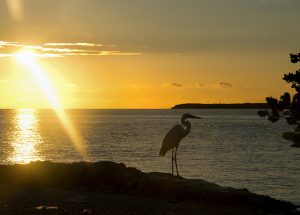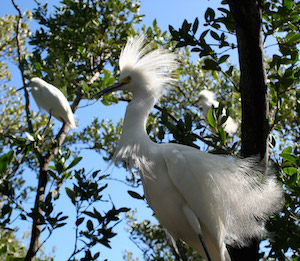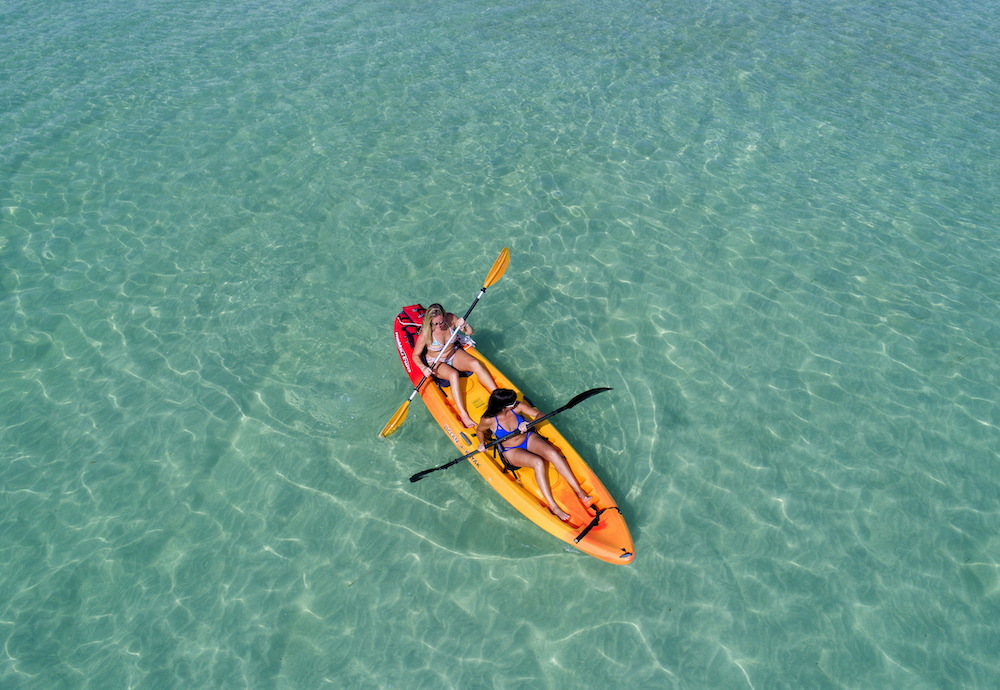Florida Keys visitors can discover a place embracing sustainability and the preservation of environmental wonders, filled with hammocks and rainforest areas, sandy beaches and on-the-water relaxation. In the vast openness of the islands, seclusion is a natural choice and horizons are endless.

Paddleboarding offers mind and body relaxation, and a perfect way to enjoy a breathtaking Keys sunset. (Photo by Rob O’Neal, Florida Keys News Bureau)
If you’re seeking on-the-water activities, kayaking and paddleboarding combine mind and body relaxation, healthful exercise and eco-experiences. Ambitious stand-up paddlers can catch tradewinds on a “downwinder” to cover distance — or use a board as a fishing or yoga platform when winds are nonexistent.
And let’s face it … few paddling experiences are more quietly enjoyable than isolated tours through backcountry flats and along the clear, shallow fringes of mangrove forests.
The Florida Keys also are among the world’s top destinations for year-round bird watching. Dagny Johnson Key Largo Hammock Botanical State Park, Long Key State Park and Dry Tortugas National Park are among Keys native habitat stops along the South Florida segment of the Great Florida Birding Trail. You can view migrating species such as warblers, white-crowned pigeons, year-round tidal waders and spring-nesting sea birds, terns, noddies, boobies and resident mangrove cuckoos and roseate spoonbills.
The Lower Keys’ National Key Deer Refuge’s 9,000-plus acres of mangrove forests, freshwater and salt marsh wetlands, pine rockland forests and tropical hardwood hammocks are an annual stopping point for thousands of migratory birds, as well as a winter home for many North American bird species.
In the Middle Keys’ Curry Hammock State Park, it’s possible to view or count thousands of falcons, raptors and eagles that fly through the Keys each fall between mid-September and early November — one of the country’s most prolific annual migration destinations for peregrine falcons.

Florida Keys refuges provide safe nesting and breeding areas for great white herons and other migratory birds. (Photo by Andy Newman, Florida Keys News Bureau)
The Great White Heron National Wildlife Refuge, established in 1938, provides safe nesting and breeding areas for great white herons (America’s largest wading bird) and other migratory birds and wildlife. Stretching between Key West and Marathon, the refuge features more than 375 square miles of open water and islands in the Gulf of Mexico — so primary access is by kayak, canoe or shallow-draft boat.
As well as being a mecca for birding enthusiasts, the Florida Keys contain several organizations that are dedicated to the rescue, rehabilitation and release of native and migratory birds back to the wild. The nonprofit Florida Keys Wild Bird Rehabilitation Center, Key West Wildlife Center and Marathon Wild Bird Center provide sanctuary for sick, injured and orphaned birds, and permanent habitat for some that can’t safely return to the wild.
Also in Marathon is the 63-acre Crane Point Hammock Museum and Nature Trails, a subtropical oasis of hardwood trees, educational displays, and trails where you can take a refreshing walk through history and nature.

A white heron preens at the Florida Keys Wild Bird Center. (Photo by Julie Botteri, Florida Keys News Bureau)
Located at mile marker 50.5 bayside, Crane Point’s slightly elevated patch of hammock is where Bahamian immigrant George Adderley and his family set up a homestead in the early 20th century. Built of tabby concrete incorporating burnt seashells, the home sheltered the Adderleys from 1903 until 1949.
The home and its beautiful surroundings remain, and are a popular stop along the 2.5 miles of trails and wooden walkways crisscrossing the hammock. Stroll along the rustic interpretive nature trails to discover endangered native foliage, unusual geologic features, colorful exotic vegetation and even ancient ocean fossils.
Whether on land or water, the Keys’ natural world provides the rejuvenation that comes from time spent outdoors — and this unique environment is just waiting to be discovered. To learn more about exploring it, just click here.

